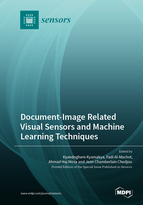Document-Image Related Visual Sensors and Machine Learning Techniques
A special issue of Sensors (ISSN 1424-8220). This special issue belongs to the section "Intelligent Sensors".
Deadline for manuscript submissions: closed (30 April 2021) | Viewed by 36741
Special Issue Editors
Interests: intelligent transport systems; telecommunications; neuro-computing; machine learning and pattern recognition; nonlinear dynamics
Special Issues, Collections and Topics in MDPI journals
Interests: machine learning; pattern recognition; image processing; data mining; video understanding; cognitive modeling and recognition
Special Issues, Collections and Topics in MDPI journals
Interests: machine learning; cognitive neuroscience; applied mathematics; machine vision
Special Issues, Collections and Topics in MDPI journals
Interests: analog computing; dynamical systems; neuro-computing with applications in systems simulation and ultra-fast differential equations solving; nonlinear oscillatory theory with applications; traffic modeling and simulation; traffic telematics
Special Issues, Collections and Topics in MDPI journals
Special Issue Information
Dear Colleagues,
Digitizing paper-based documents to cut down costs and reduce the well-known negative environmental impacts of using and wasting too much paper in offices has led to an increased focus on the systematic electronic scanning of documents through, scanners, mobile phone cameras, etc.
Generally, the quality of the captured document-images is far from good due to a series of challenges related to the performance of the visual sensors and, for camera-based captures, difficult external environmental conditions encountered during the sensing (image capturing) process. Such document-images are mostly hard to read, have low contrast and are corrupted by various artifacts such as noise, blur, shadows, spot lights, etc., just to name a few.
To ensure an acceptable quality of the final document-images that can be perfectly digitalized and involved in various high-level applications based on digital documents, the sensing process must be made much more robust than the raw capture result generated by a purely physical visual sensor. Thus, the physical sensors must be virtually augmented by a series of additional pre- and/or post-processing functional blocks, which mostly involve, amongst others, advanced machine learning techniques.
Paper submissions with innovative and robust approaches are invited for submission as they are needed to solve a series of core issues of relevance for this Special Issue:
- Visual sensors related issues w.r.t. document capture or digitization:
- Modeling and calibration of visual sensors w.r.t. various distortions
- Camera calibration concepts to robustly defocus images
- Identification, classification and characterization of visual sensor-related sources of document-image deterioration and distortion
- Sharpness quality prediction for mobile-captured document images
- Variational models for document-image binarization
- Fuzzy models for blur estimation on document images
- Adaptive binarization of degraded and/or distorted document images
- Rectification and mosaicking of camera-captured document images
- Sensor systems for low light document capture and binarization with multiple flash images
- Quality assessment of the performance of visual sensors for document capture:
- Document-image analysis
- Subjective and objective assessment of the quality of document-images w.r.t. distortions such as blur, noise, contrast, shadow, spot light, etc.
- Neurocomputing applications in image quality detection
- Post-processing of document-images (captured either by scanners or by mobile phone cameras):
- Image quality analysis and enhancement:
- Document-image degradation models
- Restoration of deteriorated document-images
- Quality enhancement of distorted (w.r.t. blur, noise, contrast, shadow, spot light, etc.) document images
- Datasets creation for the quality assessment of camera-captured images
- Perspective rectification of camera-captured document images
- Document image classification and character recognition:
- Automated and robust classification of document-images under difficult realistic conditions (i.e. deteriorated or distorted images)
- Deep learning applications in robust automated image classification
- Impact of image distortion on the readability of QR codes
- Robust optical character recognition for distorted and/or deteriorated document-images
- Image quality analysis and enhancement:
Prof. Dr. Kyandoghere Kyamakya
Dr. Fadi Al-Machot
Dr. Ahmad Haj Mosa
Dr. Jean Chamberlain Chedjou
Guest Editors
Manuscript Submission Information
Manuscripts should be submitted online at www.mdpi.com by registering and logging in to this website. Once you are registered, click here to go to the submission form. Manuscripts can be submitted until the deadline. All submissions that pass pre-check are peer-reviewed. Accepted papers will be published continuously in the journal (as soon as accepted) and will be listed together on the special issue website. Research articles, review articles as well as short communications are invited. For planned papers, a title and short abstract (about 100 words) can be sent to the Editorial Office for announcement on this website.
Submitted manuscripts should not have been published previously, nor be under consideration for publication elsewhere (except conference proceedings papers). All manuscripts are thoroughly refereed through a single-blind peer-review process. A guide for authors and other relevant information for submission of manuscripts is available on the Instructions for Authors page. Sensors is an international peer-reviewed open access semimonthly journal published by MDPI.
Please visit the Instructions for Authors page before submitting a manuscript. The Article Processing Charge (APC) for publication in this open access journal is 2600 CHF (Swiss Francs). Submitted papers should be well formatted and use good English. Authors may use MDPI's English editing service prior to publication or during author revisions.








